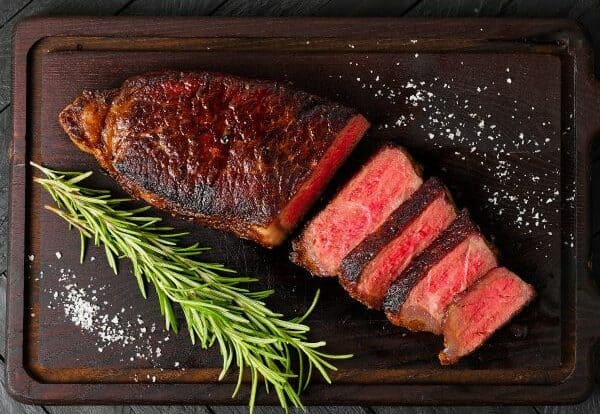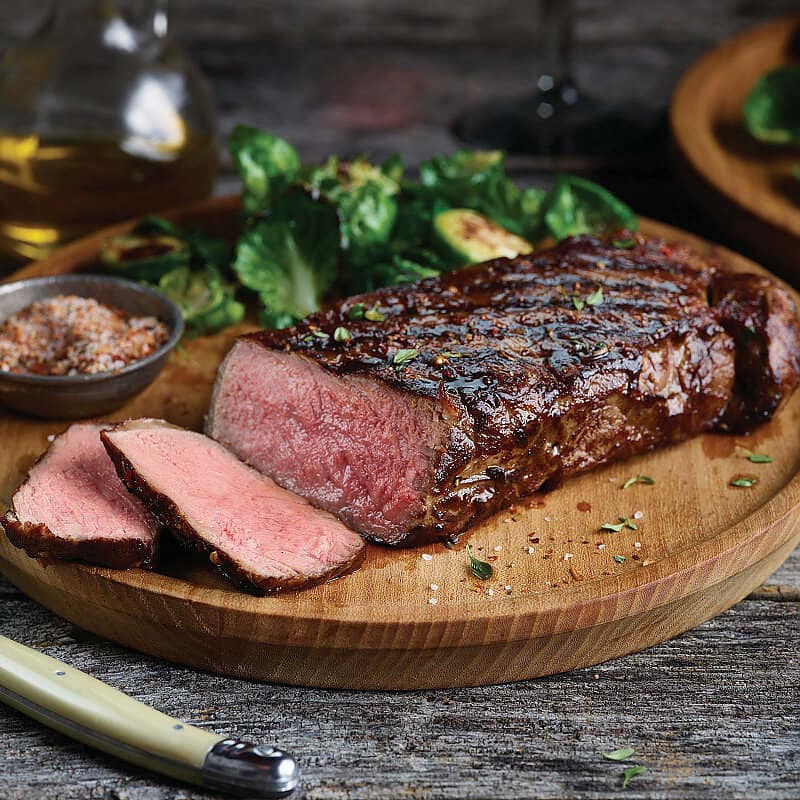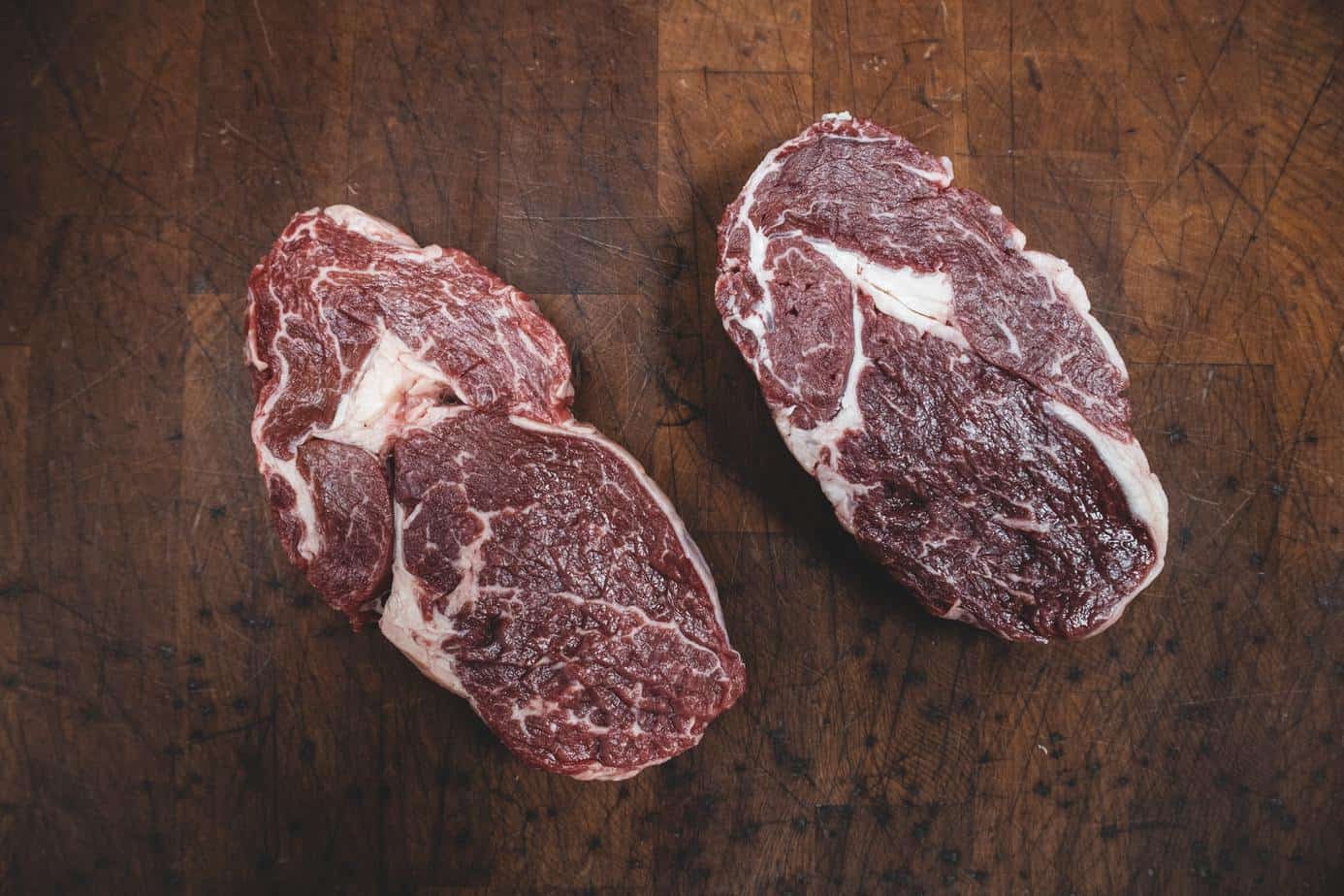- Where to Buy Meat Online: 12 Best Meat Delivery Services - April 12, 2023
- Stock Yards Review: Will Their Meat Meet Your Expectations? - April 12, 2023
- Chicago Steak Delivery Review: A Complete Guide - April 12, 2023
When it comes to strip steaks, there are two primary names you’ll see. So what’s the difference between a Kansas City strip and a New York strip? Well, not much. In fact, the cuts are identical. What you call it depends largely on where you are in the country.
In same cases, you’ll find people differentiating based on the size of the cut or who cut it, but they’re still nearly identical, so it’s not fair to say these are two different cuts. You can see for yourself if you read on.
Main Differences Between Kansas City Strip and New York Strip
The main differences between Kansas City strip and New York strip are:
- A Kansas City strip is served in the Midwest or near Kansas City whereas a New York strip is served in and around New York.
- Some say a Kansas City strip is cut by a butcher in Kansas City whereas a New York strip is cut by a chef in New York.
- A Kansas City strip is sometimes cut thinner whereas a New York strip might be a bit thicker.
- A Kansas City strip may occasionally have a larger strip of fat whereas a New York strip has had the fat trimmed off.
Kansas City Strip
I hail from Kansas City, so I’m partial to this name, even if it is the same as the New York strip (NY strip). This strip is taken from the loin primal of the animal. Due to its position, this cut of meat is very tender, and can be very flavorful, thanks to the large vein of fat that runs through it.

Kansas City boasted the largest stockyards in the country in the early 1800s, because of its wide open spaces and the cattle barons moving in. There were cattle drives cutting through the rugged terrain, and many other occupations moved to town as well, thanks to its central location and access to railroads running in all directions.
Soon, even butchers moved in, because there was plenty of work. Kansas City was also home to cowboy culture and the meat and potatoes diet so popular among the hard working. It wasn’t long before this cut of meat was dubbed the Kansas City strip.
These days, the Kansas City strip (KC strip) represents a rugged lifestyle, wholesome beef, and authentic taste, just the way a genuine cowboy would prepare it.
What's the difference between Kansas City Strip and New York Strip? We're going to fill you in on a little secret: almost nothing. It’s the bone-in version of a New York Strip. Apparently, in the 1930's, restaurants in New York City decided that selling a steak named after Kansas City (where the stockyards and slaughterhouses were located) wasn't fancy enough, so they renamed it.
New York Strip
However, Kansas City wasn’t the first to name this cut. New York had already given birth to the restaurant. In fact, Delmonico’s was luxury dining at its finest (and also where the term Delmonico Steak comes from) and they had already adopted the French term restaurant.

As beef was shipped in from the west and American capitalism was born, there was competition from everywhere. Branding was a huge part of being successful in your industry, especially if you didn’t have advertising means and word of mouth was slow.
The Delmonico chefs quickly established a name for themselves by refining this cut and calling it the New York strip. When word eventually got back to Kansas City, stockyard butchers did a bit of their own branding, too.
New York strips are often hand selected by the chef to ensure both cut and quality, and the name often insinuates top of the line steak, no matter where you’re ordering it from. The New York strip has become one of the most iconic New York steak options because of this.
The Double R Ranch New York is a traditional cut that’s the classic long and narrow shape and hand-cut to a generous 1½ inches.
Fat and Marbling
Both steaks have some marbling throughout as well as a thin vein of fat running along one side. However, there shouldn’t be any pockets of fat in the middle at all.
Preparing
Sometimes you’ll find strip steaks with the bone in. Cooking it with the bone allows for the release of flavors that you wouldn’t normally have without it. No matter whether you leave the bone in or take it out, cooking this steak right results in one of the most tender, flavorful, and juicy steaks.
Ways to Cook a Strip
Any cut of meat should be set out of the refrigerator for 30 minutes before cooking. Steak is much more tender if it’s cooked at room temperature. Taking a steak straight from the refrigerator to the stove or grill will cause the edges to tighten, giving it a tough, chewy texture.
When cooked at room temperature, you have a few more cooking options, and your steak will turn out much better in the end.
Grilling Strip Steak
Grilling is one of the most popular ways to prepare a Kansas City strip, or any steak in the Midwest for that matter. Midwesterners tend to gravitate toward the grill when preparing steaks, burgers, and many other types of meat.

While many prefer the flavor that comes from a charcoal grill, a gas grill works too. Turn your grill to medium heat and sear your steaks for about 4 minutes on each side. Be careful only to flip them once so they don’t dry out.
The beauty of doing them on the grill is that it enhances their meaty flavor more naturally than many other methods of cooking. You can use a simple salt and pepper seasoning or you can add garlic and basil for an extra kick. Try drizzling garlic butter on your finished steak for something even more savory.
Pan Searing Strip Steak
You can almost replicate a good steak on the grill using a cast iron skillet inside. This is beneficial when the weather outside doesn’t lend itself well to grilling, although true men of the meat generally don’t care.
While any type of skillet will work, a cast iron skillet is better suited to searing steak. It takes about 5 minutes on each side on medium heat, but be careful to prep your skillet with cooking spray or something that will keep your steak from sticking.
Sear Roasting Strip Steak
You can also sear your steak quickly in a pan and then finish cooking it in the oven. A cast iron skillet is still the best for searing both sides of your steak because then you can put it straight in the oven to finish it.
Sear your steak for about 2 minutes on each side, using medium high heat. This gives you that seared skin you love while doing a better job of keeping the juices in once you put it in the oven.
It only takes about 3-4 minutes in the oven at 500 degrees Fahrenheit to finish it to perfection.
Broiling Strip Steak
If you’d rather cook your steak in the oven, you can do this for about 6-7 minutes on each side. It takes a bit longer, but it ensures you won’t burn your steak or dry it out. While it does a great job of keeping the juices in, it won’t impart that traditional grill flavor many enjoy.
All steaks will continue to cook after you remove them from heat, so it’s especially important when broiling them that you don’t cook them for too long, or they’ll end up being more done than you want them to be.
How to Tell if Your Strip is Done
Everyone has a preference on how they like their steak cooked. Some like it red in the middle while others don’t want to see any pink at all. For your safety, the USDA recommends that steak be cooked to at least 145 degrees Fahrenheit, which is considered medium. There will be a bit of pink in the center, but this isn’t everyone’s favorite. Here’s a breakdown of what steak is called based on the way it’s cooked.
What is an Extra Rare Strip Steak?
While very few people actually like it this way, my husband included, this cut maintains the most juice. It also remains very tender. It will have an internal temperature of 115-120 degrees Fahrenheit and be very red in the middle.

What is a Rare Strip Steak?
This rarity is slightly more tolerable. There will still be a considerable amount of pink, but won’t be nearly as red as extra rare. It will have a cool pink center, cooked to 125 or 130 degrees. It is very tender and flavorful. Most steak lovers argue that this is the best way to prepare a steak.
What is a Medium Rare Strip Steak?
Medium rare is heated to 130 or 140 degrees. It will still be pink, but the center will be warm. It’s still juicy, tender, and flavorful, but more palatable for those who can’t stand too much rarity.
What is a Medium Strip Steak?
Medium is just barely pink with an internal temperature ranging from 140-150 degrees. It’s my favorite, because the flavor hasn’t yet been cooked out and it’s still tender and juicy, but not quite as pink.

What is a Medium Well Strip Steak?
Most steak aficionados will argue that anything above medium is too done. However, some people can’t stand the sight of red or pink in their steak. This cut is completely warm and there will be no sight of pink anywhere. It is cooked to 150 or 155 degrees.
What is a Well Done Strip Steak?
This, ladies and gentleman, is a hockey puck. No one should be eating their steak this way! The internal temperature of this one is above 160 degrees Fahrenheit. All of the flavor and the juices have been cooked away, and sometimes the outside will even be crispy.
However, people who aren’t interested in eating their steak unless they’re sure it’s dead first will order it this way. If you’ve never tried a steak any less done than this, please do.
Best Strip Steak Recipes
There are quite a few ways you can cook a strip, but here are some of my favorites. Try these if you’re interested in experimenting with the very versatile strip.
Garlic Butter Strip

You can’t go wrong marinating your strip in some garlic and then topping it with melting butter. You can cook this on the grill or indoors, but I would recommend pan searing it to perfection or grilling it as the two best ways to prepare it.
Marinate your steak in ½ cup of olive oil, ¼ cup of lemon juice, three cloves of garlic, two teaspoons of Worcestershire sauce, and a dash of pepper. Make sure the plastic bag is air tight and that the entire steak is covered. Marinate it in the refrigerator or at room temperature. This amount of marinade will cover about 6 steaks.
When you’re ready, drizzle your cast iron skillet with oil, or prepare your grill. Turn the heat to medium-high and let it heat up. Then cook the steaks for about 5 minutes on each side for medium. Adjust your cooking time based on how you like your steaks.
After removing the steaks, cover them with foil to keep them warm while they rest for 5-10 minutes. Drop a scoop of butter on top of each one as you serve them.
Garlic and Rosemary Rub
Rather than marinating your steak, you may want to create a rub instead. This rub makes for an excellent strip, no matter how you choose to cook it. The proportions will cover about 4 strips.

Chop three cloves of garlic and two tablespoons of rosemary. Add two teaspoons of sea salt and rub your steaks with this mixture. Allow them to sit for 20 minutes. Add pepper to taste and your strips are ready to cook.
If you’re cooking them on the grill, they’re ready to go. If you’d rather cook them inside, add four tablespoons of butter and a tablespoon of olive oil to your pan. Cook the steaks on medium-high for two minutes on the first side.
When you flip them, you can add sliced shallots and a tablespoon of white wine to enhance the flavor even more. Let the steaks rest 5-10 minutes before serving.
Traditional Kansas City Strip

Here’s the easiest strip steak you’ll ever make. True to Kansas City tradition, simply season your KC strip steak with salt and pepper and let sit for about 20 minutes. Then cook it on the grill for 3-5 minutes on each side. Let it rest for 5-10 minutes and serve.
It’s minimalistic, easy, and stays true to the flavor of this Kansas City steak. If you really want to enhance the flavor, use pink Himalayan salt instead. It really brings out the savory meat flavors.
Best Sides for Kansas City or New York Strip Steak
Strip steaks are pretty versatile and go well with plenty of different sides.
For a hearty meal, choose a baked potato. Any kind of potato generally goes well with a steak anyway. If you’d rather keep it light, serve your steak with a salad and a side of asparagus.
For those who want all the fixins, steak, potatoes, green beans, fries, and biscuits will feed a large family.
You can even mix it up and serve steak with onion rings, cheesy fries, Brussels sprouts, or anything you love.
KC Strip & NY Strip Alternatives
While Kansas City strip and NY strip steak may be eerily similar, there are plenty of other cuts that are very different and worth a try if you love steak.
Filet Mignon
Filet mignon has a more delicate flavor. It’s typically a smaller steak, often bacon wrapped, and known for its tender texture. This steak is a favorite among those who don’t like their steak to have an overwhelming beefy flavor.
When cooked right, this steak will melt in your mouth. It’s similar to a strip in its abundance of juicy, savory, mouthfeel, but slightly more tender.

Ribeye Steak
This is a favorite among steak lovers because it has a strong, beef flavor. For those who love steak, ribeye is perhaps the best one to try. It features some fat that lends to its flavor, and its marbling is similar to a strip. It’s also close in size to a strip, so it’s a perfect choice for a hearty appetite.

FAQ
We’ve already cleared up that these two cuts of steak are the same, but there still may be some lingering questions. These frequently asked questions should help you understand more about this incredible cut of meat.
Answer: Kansas City strips are second to none in quality and taste. Whether it’s masquerading as a strip from Kansas City or New York, it’s going to contain rich steak flavor and incredible tenderness. Midwestern beef is generally boneless, but if you do find a bone, it only enhances the flavor.
Answer: Kansas City’s culinary scene is known far and wide for adventurous dining, including steak. In fact, its reverence for steakhouses above all else is still ingrained in its culture. There are casual steak joints as well as fine dining steakhouses, and everything in between.
Answer: A New York strip is more tender and flavorful, but it’s also very expensive, even for a New Yorker. A sirloin will be much cheaper, and can still be enjoyable if prepared correctly. However, if you’re looking for the best, you’ll want to try the strip.
Answer: This is a true head-to-head comparison of a great steak. A ribeye will have more internal marbling and fat, giving it a ton of flavor, a smooth texture, and a lot of tenderness. For those who really want a lot of beefy taste, the ribeye is one of the best options.
A Kansas City strip has a band of fat running along the side, but much less in the middle. It still has an excellent texture and flavor as well as a lot of juicy, savory taste, but it isn’t as powerful as the ribeye.
The most convenient way to shop life-changing meat. Delivered on your schedule, every 2, 4, or 8 weeks. Get 10% Off your first order using code: RAISEDBETTER10.
Final Thoughts on NY Strip vs Kansas City Strip
There’s no difference between a Kansas City strip and a New York strip steak, so stop fretting about which you should order. You’ll enjoy both. If you see both on a restaurant menu, ask the chef to clarify the difference according to them.
Both are cut from the same part of the cow, although sometimes it will have a bone and sometimes it won’t. You will certainly enjoy this steak, because it’s one of the most tender you can get. It’s juicy, flavorful, and savory.
What's the difference between Kansas City Strip and New York Strip? We're going to fill you in on a little secret: almost nothing. It’s the bone-in version of a New York Strip. Apparently, in the 1930's, restaurants in New York City decided that selling a steak named after Kansas City (where the stockyards and slaughterhouses were located) wasn't fancy enough, so they renamed it.
The Double R Ranch New York is a traditional cut that’s the classic long and narrow shape and hand-cut to a generous 1½ inches.




